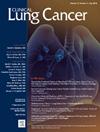Brief Report: The Immune Profiles of the Molecular Subtypes of EGFR-Mutant Lung Adenocarcinomas in a Large Real-World Cohort
IF 3.3
3区 医学
Q2 ONCOLOGY
引用次数: 0
Abstract
- •EGFR-mutant tumors with exon 19 deletions, L858R mutations, or exon 20 insertions were less likely to be PD-L1 high (TPS ≥ 50%) or TMB high (≥10 mut/MB) as compared to wild-type (WT) tumors. Among EGFR-mutant tumors, those with uncommon alterations in L861Q and G719X had greater rates of TMB high and TP53 co-mutations.
- •Utilizing bulk RNA sequencing data to characterize the immune tumor microenvironment (TME), exon 19 deletion and L858R mutation tumors were found to have lower median percent fractions of CD8+ T cells versus WT. However, a wide range of values for CD8+ T cells was observed and a subset of exon 19 deletion and L858R tumors had higher values comparable to WT.
- •Exon 19 deletion, L858R, and exon 20 insertion tumors were enriched with immunosuppressive M2 macrophages and neutrophils as compared to WT. In contrast, L861Q and G719X tumors had levels of M2 macrophages similar to WT.
- •A small subset of EGFR-mutant tumors, particularly those with uncommon alterations, bear characteristics that may render them more immunogenic. Continued research is needed to evaluate biomarkers, including the specific subtype of EGFR, as predictors of immunotherapy response to better identify the small subgroup of patients with EGFR-mutant disease that benefit from checkpoint inhibitors.
简要报告:一个大型真实世界队列中表皮生长因子受体突变肺腺癌分子亚型的免疫概况
-与野生型(WT)肿瘤相比,具有外显子19缺失、L858R突变或外显子20插入的表皮生长因子受体(EGFR)突变肿瘤不太可能出现PD-L1高表达(TPS≥50%)或TMB高表达(≥10突变/MB)。在表皮生长因子受体(EGFR)突变的肿瘤中,L861Q和G719X发生不常见改变的肿瘤具有更高的TMB高和TP53共突变率。利用批量RNA测序数据来描述免疫肿瘤微环境(TME)的特征,发现外显子19缺失和L858R突变的肿瘤与WT相比,CD8+ T细胞的中位百分比较低。然而,CD8+ T 细胞的数值范围很广,外显子 19 缺失和 L858R 肿瘤的一个子集具有与 WT 相当的较高数值。与 WT 相比,外显子 19 缺失、L858R 和外显子 20 插入肿瘤富含免疫抑制性 M2 巨噬细胞和中性粒细胞。相比之下,L861Q 和 G719X 肿瘤的 M2 巨噬细胞水平与 WT 相似。需要继续研究评估生物标志物,包括表皮生长因子受体的特定亚型,作为免疫疗法反应的预测指标,以更好地识别从检查点抑制剂中获益的一小部分表皮生长因子受体突变患者。
本文章由计算机程序翻译,如有差异,请以英文原文为准。
求助全文
约1分钟内获得全文
求助全文
来源期刊

Clinical lung cancer
医学-肿瘤学
CiteScore
7.00
自引率
2.80%
发文量
159
审稿时长
24 days
期刊介绍:
Clinical Lung Cancer is a peer-reviewed bimonthly journal that publishes original articles describing various aspects of clinical and translational research of lung cancer. Clinical Lung Cancer is devoted to articles on detection, diagnosis, prevention, and treatment of lung cancer. The main emphasis is on recent scientific developments in all areas related to lung cancer. Specific areas of interest include clinical research and mechanistic approaches; drug sensitivity and resistance; gene and antisense therapy; pathology, markers, and prognostic indicators; chemoprevention strategies; multimodality therapy; and integration of various approaches.
 求助内容:
求助内容: 应助结果提醒方式:
应助结果提醒方式:


